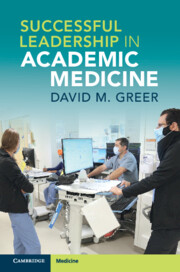Book contents
- Successful Leadership in Academic Medicine
- Successful Leadership in Academic Medicine
- Copyright page
- Contents
- Preface
- Chapter 1 Why Do You Want to Lead?
- Chapter 2 Understanding Your Personality as a Leader
- Chapter 3 Your Team
- Chapter 4 Setting the Vision
- Chapter 5 Building the Culture
- Chapter 6 Running an Effective Meeting
- Chapter 7 Aligning Goals with Hospital and Medical School Leadership
- Chapter 8 Having Difficult Conversations
- Chapter 9 Leadership in a Crisis
- Chapter 10 Medical Leadership 2.0
- Appendix 1 BU Neurology Vision Statement 2020
- Resources
- Index
Chapter 6 - Running an Effective Meeting
Published online by Cambridge University Press: 20 May 2022
- Successful Leadership in Academic Medicine
- Successful Leadership in Academic Medicine
- Copyright page
- Contents
- Preface
- Chapter 1 Why Do You Want to Lead?
- Chapter 2 Understanding Your Personality as a Leader
- Chapter 3 Your Team
- Chapter 4 Setting the Vision
- Chapter 5 Building the Culture
- Chapter 6 Running an Effective Meeting
- Chapter 7 Aligning Goals with Hospital and Medical School Leadership
- Chapter 8 Having Difficult Conversations
- Chapter 9 Leadership in a Crisis
- Chapter 10 Medical Leadership 2.0
- Appendix 1 BU Neurology Vision Statement 2020
- Resources
- Index
Summary
Most meetings are not run efficiently or effectively, and very few leaders put the time and energy into running a meeting well, not only wasting the time of their audience but their own as well. Without question, some meetings, or at least portions of meetings, are necessarily informative and perfunctory, such as updates on the financial situation of a department or the medical center or school. But not all meetings have to be like that, and nor do all portions of a given meeting. This chapter gives some tips for running an effective meeting, getting the most out of your group in the process, and having the group feel not only updated but engaged, respected, and perhaps even inspired. We talk about how to get people engaged from the get-go and the importance of setting the tone and expectations for meetings at the very start. We discuss the importance of setting the agenda and giving people prework so that they come prepared and ready for discussion. We get into the importance of establishing trust in meetings, so that people can speak freely and without fear of recrimination or attack. We talk about how to foster a constructive dialogue, allowing people to spread their wings and explore their creative sides, but also how to deal with a negative team member who makes others uncomfortable. And we talk about how to wrap up a meeting, discuss next steps, and have the group leave excited for the next meeting. We conclude with how to conduct a retreat for your group.
- Type
- Chapter
- Information
- Successful Leadership in Academic Medicine , pp. 54 - 63Publisher: Cambridge University PressPrint publication year: 2022



